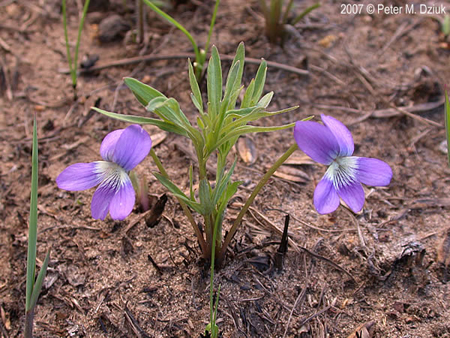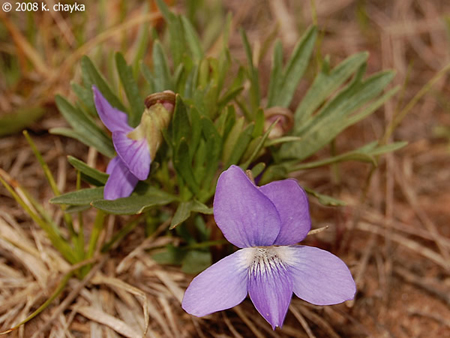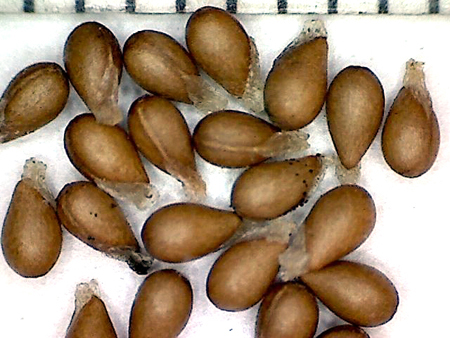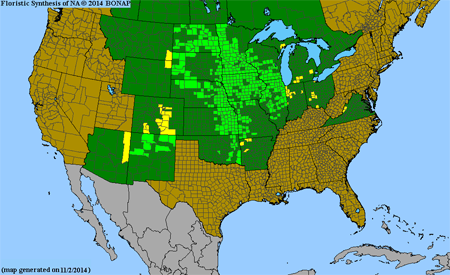Viola pedatifida G.Don
Common names:
Larkspur Violet, Prairie Violet
Synonyms:
Viola pedatifida G.Don, Gen. hist. 1: 320. 1831; Viola palmata L. var. pedatifida (G.Don) Cronquist, Man. Vasc. Pl. NorthE. U.S. Canad., ed. 2: 864. 1991 [Don did not cite a type or note a more specific location than "North America"; this requires neotypification.]
Viola delphinifolia Nutt. ex Torr. & A.Gray, Fl. N. Amer. 1(1): 136. 1838
Description:
Acaulescent rosulate perennials from thick rhizome, ≤ 27 cm tall; foliage and peduncles green with lower surface of leaf blades often tinged purple, petioles and peduncles glabrous or occasionally sparsely hirtellous (possibly resulting from hybridization with V. sororia), leaf blades finely appressed-hirtellous along veins and ciliolate; stipules free, irregularly glandular-fimbriate; homophyllous, leaves erect to ascending, smallest leaf blades palmatifid, largest deeply (sub)triternately divided into (13)17–25 narrowly linear ultimate lobes, central lobe of terminal primary division not distinctly broader than its lateral lobes, largest ≤ 55 × 87 mm, outline deltate-reniform or less often broadly ovate, base broadly cuneate to subcordate, margins entire, appressed-ciliolate, apex obtuse to truncate; chasmogamous peduncle held among or above the leaves; chasmogamous flower <& le; 25 mm; calyx glabrous, ciliate; lowest sepals lanceolate, acuminate; auricles short to somewhat prominent and entire, elongating to 3 mm in fruit; corolla blue to purple, throat white; spur short-globose; lateral petals densely bearded with filiform to narrowly linear hairs, spurred petal densely bearded; cleistogamous flowers produced after chasmogamous, peduncle erect and commonly shorter than the petioles; capsule 9–12 mm, green drying tan, unspotted, glabrous; seeds 1.7–2.2(2.5) × 1.1–1.3 mm, medium brown, unspotted; 2n=54.
Similar species:
The broadly ovate to deltate-reniform triternately divided leaf blades with slender linear ultimate segments are distinctive in this species and few others can be confused with it. It occasionally grows with V. pedata in drier prairies and the two are commonly mistaken for each other, but this species can immediately be distinguished by its ascending elongate rhizome, 2- to 3-times divided terminal primary division on the largest leaf blades, free stipules, and densely bearded lateral and spurred petals. Like all other native Viola species in our region except for V. pedata, it expresses a mixed breeding system that shifts to cleistogamy in the summer, in which the capsules can easily be identified as cleistogamous by the tiny tightly curled style at the apex; V. pedata is strictly chasmogamous and, as such, does not produce such capsules after chasmogamous flower. This species can be distinguished from V. brittoniana, the other cut-leaved species in the Pedatifida group, by its more extensively divided leaf blades with equally slender ultimate segments, usually ciliate sepals, and larger seeds. It was previously confused with but is different from V. tenuisecta in its triternate leaf blades appressed-hirtellous along veins, lanceolate sharply acuminate ciliate sepals, prominent auricles, densely bearded spurred petal, unspotted cleistogamous capsule on an erect peduncle, and unspotted brown seeds. It can be distinguished from V. baxteri and V. subsinuata by its more restricted and leaf pubescence composed of shorter hairs, lanceolate sharply acuminate ciliate sepals, prominent auricles, densely bearded spurred petal, unspotted cleistogamous capsule on an erect peduncle, and unspotted brown seeds.
Ecology:
Rich organic often alkaline loam of dry-mesic and mesic prairies, openings in savannas.
Distribution:
Great Plains and Prairie Province, w. MI and w. IN to AB, south to nw. AR, e. OK, NM and AZ, slightly disjunct in s.-c. Ontario near Brantford, and in n. and e. OH on the basis of old herbarium specimens where the species may now be extirpated.
Rarity:
State listed in IN, MI, and OH.
Phenology:
Chasmogamous flower April–May, chasmogamous fruit May–June, cleistogamous fruit May–August.
Affinities:
This species belongs to the Acaulescent Blue Violet lineage, sect. Nosphinium W.Becker, subsect. Boreali-Americanae (W.Becker) Gil-ad, in the Pedatifida species group.
Hybrids:
Hybridizes with V. communis (Greene 1903a, Brainerd 1913a, 1924), V. missouriensis (Ballard 2013), V. nephrophylla (Brainerd 1913a, 1924), V. sagittata (Brainerd 1913a, 1924, Ballard 2013), V. sororia sensu stricto (Greene 1898a, 1903a, 1906b, Brainerd 1913a, 1924, Ballard 1995, 2013), and V. "sororia glabrous" (Brainerd 1913a, 1924). Brainerd reported that hybrids express intermediate or recombinant traits in foliage, chasmogamous flowers, cleistogamous capsules and seeds (when these do not abort). None of the hybrids reproduce by chasmogamous flowers. Brainerd reports dramatic reductions of viable seeds in the cleistogamous capsules of all hybrids studied. I have observed many herbarium specimens and living plants at many sites of hybridization in the eastern portion of the range of V. pedatifida and confirm Brainerd's observations.
Comments:
Brainerd (1921b), Brainerd Baird (1942), Fernald (1950), Alexander (1963), Russell (1965), Scoggan (1978), Swink and Wilhelm (1979), Ballard (1995, 2013), Gil-ad (1995, 1997, 1998), and Voss and Reznicek (2012) recognized this as a distinct species. Russell stated that it intergraded with V. palmata [V. baxteri as treated here] at the east end of its range, but he interpreted collectively hybrid specimens with V. sororia in southwestern Michigan and specimens of V. baxteri as a continuum of "intergradation" between midwestern V. pedatifida and Appalachian V. subsinuata (which Russell called V. palmata). Gleason and Cronquist (1991) similarly viewed the two taxa as intergrading and merged them as varieties under V. palmata. McKinney (1992) and McKinney and Russell (2002) recognized the close similarity of V. brittoniana and the present species and reduced the former to a subspecies under V. pedatifida. Little and McKinney (2015) later reinstated V. brittoniana to species rank. Such hybrids in the eastern portion of the range of V. pedatifida have often been confused with V. baxteri but are subfertile, produce recombinant cleistogamous seeds and progeny, and are invariably intimately associated with one or both parental species. This very morphologically uniform species is almost entirely confined to mesic blacksoil prairies and other prairie-like sites, with its midwestern range tightly adhering to Transeau's (1935) Prairie Peninsula. Many populations in the southwestern Great Lakes region have been extirpated by habitat conversion of roadside and railroad rights-of-way in the last two decades, heavily fragmenting the eastern portion of its geographic distribution and nearly eliminating its Prairie Peninsula distribution. It hybridizes with V. sororia very commonly, wherever its grassland habitat contacts the woodland habitat of the latter species. The taxon represented by disjunct populations in the shale barrens region of montane western Virginia, originally reported as V. pedatifida by Platt (1950) and characterized further by Weakley et al. (2012), were more recently revealed by Zumwalde (2015) to be a highly distinctive county-level endemic, V. tenuisecta.
Literature Cited:
Alexander, E. J. 1963. Violaceae. In Gleason, H. A., The new Britton and Brown illustrated flora of the northeastern United States and adjacent Canada. Hafner Publishing Co., Inc., New York, NY. 552-567.
Ballard Jr., H. E. 1995 ["1994"]. Violets of Michigan. Michigan Botanist 33: 131-199.
Ballard Jr., H. E. 2013. Violaceae. In Yatskievych, G., Flora of Missouri. Missouri Botanical Garden Press, St. Louis, MO. 1218-1243.
Brainerd, E. 1913a. Four hybrids of Viola pedatifida. Bulletin of the Torrey Botanical Club 40: 249-260.
Brainerd, E. 1921b. Violets of North America. Vermont Agricultural Experiment Station Bulletin 224: 1-172.
Brainerd, E. 1924. The natural violet hybrids of North America. Vermont Agricultural Experiment Station Bulletin 239.
Brainerd Baird, V. 1942. Wild violets of North America. University of California Press, Berkeley, CA.
Fernald, M. L. 1950. Violaceae. In Gray’s Manual of Botany, 8th ed. American Book Company, New York, NY. 1022-1042.
Gil-ad, N. L. 1995. Systematics and evolution of Viola L. subsection Boreali-Americanae (W. Becker) Brizicky. Ph.D. dissertation. University of Michigan, Ann Arbor, MI.
Gil-ad, N. L. 1997. Systematics of Viola subsection Boreali-Americanae. Boissiera 53: 1-130.
Gil-ad, N. L. 1998. The micromorphologies of seed coats and petal trichomes of the taxa of Viola subsect. Boreali-Americanae (Violaceae) and their utility in discerning orthospecies from hybrids. Brittonia 50: 91-121.
Gleason, H. A., and A. Cronquist. 1991. Violaceae. In Manual of vascular plants of northeastern United States and adjacent Canada, 2nd ed. New York Botanical Garden, Bronx, NY. 157-163.
Greene, E. L. 1898a. New or noteworthy species.-XXI. Pittonia 3: 257-263.
Greene, E. L. 1903a. The genus Viola in Minnesota-I. Pittonia 5: 115-133.
Greene, E. L. 1906b. Mutations in Viola. Leaflets of Botanical Observation and Criticism 1: 182-187.
Little, R. J., and L. E. McKinney. 2015. Violaceae. In Flora of North America: Cucurbitaceae to Droseraceae, 106. Oxford University Press, New York, NY.
McKinney, L. E. 1992. A taxonomic revision of the acaulescent blue violets (Viola) of North America. Sida, Botanical Miscellany 7: 1-60.
McKinney, L. E., and N. H. Russell. 2002. Violaceae of the southeastern United States. Castanea 67: 369-379.
Platt, R. B. 1950. Two mid-Appalachian violets. Castanea 15: 126-129.
Russell, N. H. 1965. Violets (Viola) of the central and eastern United States: An introductory survey. Sida 2: 1-113.
Scoggan, H. J. 1978. Violaceae. In Flora of Canada, Part 3–Dicotyledoneae (Saururaceae to Violaceae). National Museums of Canada. Ottawa, Canada. 1103-1115.
Strausbaugh, P. D., and E. L. Core. 1978. Violaceae. In Flora of West Virginia, 2nd ed. Seneca Books, Inc., Morgantown, WV. 644-658.
Swink, F., and G. Wilhelm. 1979. Violaceae. In Plants of the Chicago region, 2nd ed. revised and expanded. Morton Arboretum, Lisle, IL. 384, 801-810.
Transeau, E. N. 1935. The prairie peninsula. Ecology 16(3): 423-437.
Voss, E. G., and A. A. Reznicek. 2012. Violaceae. In Field manual of Michigan flora. The University of Michigan Press, Ann Arbor, MI. 913-922.
Weakley, A. S., J. C. Ludwig, and J. F. Townsend. 2012. Violaceae. In Flora of Virginia. BRIT Press, Fort Worth, TX. 963-975.
Zumwalde, B. A. 2015. A systematic revision of the Viola pedatifida group and evidence for the recognition of Viola virginiana, a new narrow endemic of the Virginia shale barrens. M.S. thesis. Ohio University, Athens, OH.

Chasmogamous flowering habit by Peter M. Dziuk, "Minnesota Wildflowers" website

Leaf by Peter M. Dziuk, "Minnesota Wildflowers" website

Chasmogamous flowers front and profile view by Katy Chayka, "Minnesota Wildflowers" website

Seeds from herbarium specimen: MN, plant X, O. Gockman s.n. (BHO)

Map by the Biota of North America Program (records in e. IN, se. MI and w. OH are V. baxteri; VA records are V. tenuisecta)